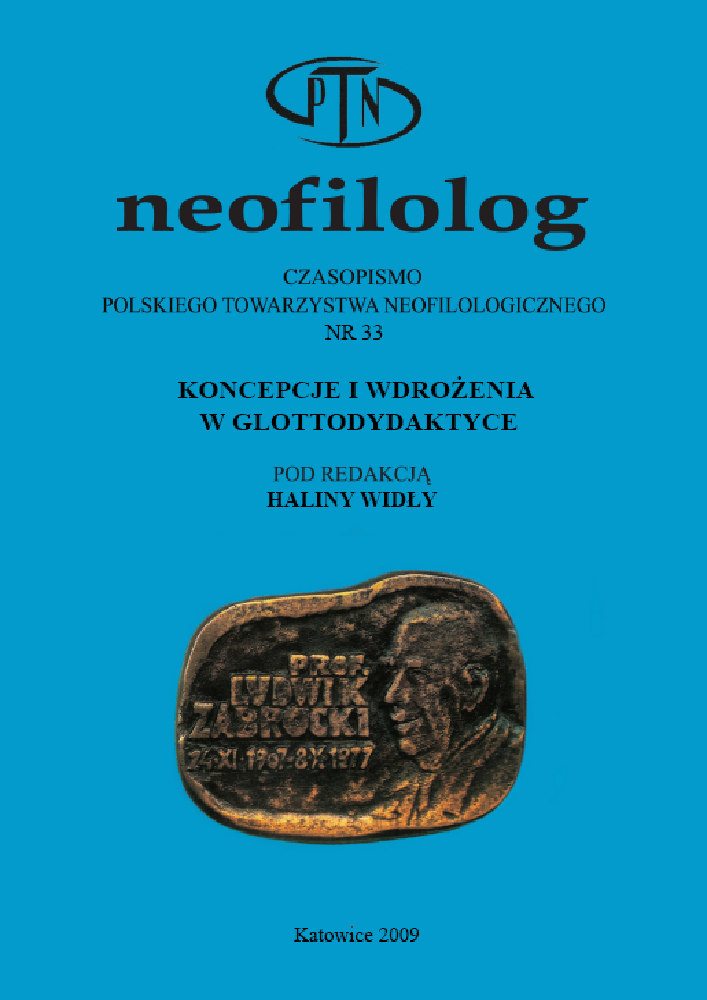Résumé
This paper aims to explore the rationale of classroom negotiation - understood as a discussion between all participants in the teaching/learning process to decide on the organization of foreign language learning and teaching. It outlines relevant issues connected with the process syllabus and the benefits that can be expected from involving students in classroom decision making. The article presents results of research conducted in Polish schools among both students and teachers at different levels of education in order to see to what extent the foreign language syllabus is negotiated there.
Références
Bloor, M. i Bloor, T. 1988. “Syllabus negotiation: the basis of learner autonomy” (w) Individualization and Autonomy in Language Learning. ELT documents 131. (red. A. Brookes i P. Grundy). London: Modern English Publications and the British Council.
Breen, M. 1987. “Contemporary paradigms in syllabus design”. Language Teaching 20, cz. 1 i 2, 81 – 92, 157 – 174.
Breen, M. i Littlejohn, A. 2000. “The significance of negotiation” (w) Classroom Decision-Making. Negotiation and Process Syllabuses in Practice. (red. M. Breen i A. Littlejohn). Cambridge: CUP.
Breen, M. i Littlejohn, A. 2000. “The practicalities of negotiations” (w) Classroom Decision-Making. Negotiation and Process Syllabuses in Practice. (red. M. Breen i A. Littlejohn). Cambridge: CUP.
Budd, R i Wright, T. 1992. “Putting a process syllabus into practice” (w) Collaborative Language Learning and Teaching. (red. D. Nunan). Cambridge: CUP.
Ellis, R. 1994. The Study of Second Language Acquisition. Oxford: OUP.
Long, M. 1981. “Input, interaction and second language acquisition” (w) Native Language and Foreign Language Acquisition. (red. H. Winitz, 32 – 47). New York: New York Academy of Science.
McDevitt, B. 2004.”Negotiating the syllabus: a win-win situation?”. ELT Journal 58(1), 3 – 9.
Nowak, S. 2008. Metodologia badań społecznych. Warszawa: Wydawnictwo Naukowe PWN.
Nunan, D. 1999. Second Language Teaching and Learning. Boston: Heinle & Heinle Publishers.
Rogers, C. 1969. Freedom to Learn. Colombus, OH: Merrill.
Sudman, S. 1976. Applied Sampling. Orlando: Orlando Academics Press.
Underhill, A. 1989. “Process in humanistic education”. English Language Teaching Journal, 43 (4), 250-260.
Tudor, I. 1996. Learner-centredness as Language Education. Cambridge: CUP.
Widdowson, H.G. 1978. Teaching Language as Communication. Oxford: OUP.
Licence
© Paweł Sobkowiak 1970

Ce travail est disponible sous licence Creative Commons Attribution - Pas de Modification 4.0 International.
Auteurs :
Les auteurs de textes acceptés pour publication dans la revue Neofilolog sont tenus de remplir, signer et renvoyer à l'adresse de la rédaction, un accord sur l'octroi d'une licence gratuite pour les œuvres, avec obligation d'accorder une sous-licence CC.
En vertu de cet accord, les auteurs des textes publiés dans la revue Neofilolog accordent à l'Université Adam Mickiewicz de Poznań une licence non exclusive et gratuite et permettent l'utilisation de la sous-licence Creative Commons Attribution-NoDerivatives 4.0 International (CC BY-ND 4.0).
Les auteurs se réservent le droit de disposer librement de l'œuvre.
Utilisateurs :
Les utilisateurs d'Internet intéressés ont le droit d'utiliser les œuvres publiées à partir de l'année 2017 sous réserve des conditions suivantes :
- reconnaissance de la qualité d'auteur - l'obligation de fournir des informations sur la qualité d'auteur, le titre, la source (liens vers l'œuvre originale, DOI) et la licence, ainsi que l'œuvre distribuée ;
- sans créer d'œuvres dérivées - l'œuvre doit être conservée dans sa forme originale, p. ex. les traductions ou les interprétations ne peuvent être distribuées sans le consentement de l'auteur.
Tous les textes publiés sont soumis au droit d'auteur.
Autres :
L'Université Adam Mickiewicz de Poznań se réserve le droit à la revue dans son ensemble (mise en page, forme graphique, titre, conception de la couverture, logo, etc.).
.
